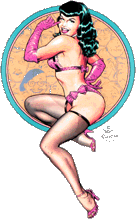

|
Cheesecakeand The Art of the Pin-upComics Etc.pin-up n. |

|
So far, the artists I've covered have shown a continuing trend from the soft focus and romantic style of the early artists and illustrators to an ever-sharper look, moving through realism and beyond. The next artist reverses the trend. To the right here we have "The Girl of Our Dreams" a portrait of Bettie Page by Dave Stevens.
In some ways, Dave's style is the comic book equivalent of the super-realist school. His line work is sharp and clear and his curves full and sensuous. What sets him apart is his choice of subject. More than any other individual Stevens is responsible for the Bettie Page revival of the 80's and 90's. What he makes us see in Bettie is not merely her beauty, but her innocence. Bettie, the so-called "Queen of the Pin-ups" is perhaps the most photographed model of the 20th century. Why is that? It's not, I think, for her looks but for her personality. Somehow Bettie managed to bring joy, fun and innocence to every picture taken of her, be it clothed or nude, pin-up or bondage. Photographs by minimally talented amateurs or the finest glamour photographers of the day show us the innocence and cheerfulness that she brought to the camera.
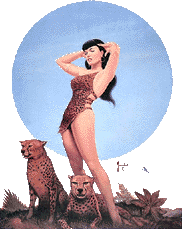 By bringing us back to Bettie as a model, Dave did a lot to return us to
the innocence and romanticism of the early cheesecake. Many artists over
the years learned to draw beautiful women by sketching Bettie. Once Dave
brought her back into the spotlight, many many more followed suit.
Olivia has done many pictures of Bettie, as have many other old pros,
but also, a large number of new pin-up artists have started to appear,
artists who revive the style of vintage cheesecake or the paperback book
covers of Bettie's days.
By bringing us back to Bettie as a model, Dave did a lot to return us to
the innocence and romanticism of the early cheesecake. Many artists over
the years learned to draw beautiful women by sketching Bettie. Once Dave
brought her back into the spotlight, many many more followed suit.
Olivia has done many pictures of Bettie, as have many other old pros,
but also, a large number of new pin-up artists have started to appear,
artists who revive the style of vintage cheesecake or the paperback book
covers of Bettie's days.
If Dave kicked off the Bettie Page revival, it was
Greg
Theakston
who kept it alive with his 'zine "The Betty Pages". Theakston published
articles, pictures and the chronicle of his search for Bettie. Since
Miss Page had vanished in the 50's the "The Betty Pages" couldn't really
survive on pure Bettie, so Theakston also included articles and pictures
of other pin-ups, thus fueling the whole cheesecake and pin-up revival.
The picture of Betty and the leopards to the left is Theakston's cover
for the second Betty Pages Annual. It is based on pictures from one of
Bettie's most famous shoots with photographer Bunny Yeager. When Bettie
was found, Theakston retired "The Betty Pages" and replaced it with the
more general "Tease".
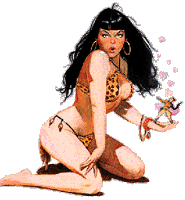
Another artist inspired by Bettie is Jim Silke, a newcomer to the comics field, though not to graphic arts. Silke retired a couple of years back after a career that included art director, magazine editor and publisher, glamour photographer, historian and screen writer. A couple of years later, Dark Horse Comics published Rascals in Paradise, a three-issue comic written and drawn by Silke. The art in Rascals owes a lot to the cheesecake tradition as well as to paperback cover and movie poster art, movies themselves and the "good girl" comics of the 40's. Recently, Playboy and Dark Horse have created and on-line version of Rascals in Paradise, and other comics.
In 1995, Dark Horse published Silke's book, Bettie Page: Queen of Hearts, which I've reviewed along with his more recent Pin- up: The Illegitimate Art. Besides giving an excellent insight into both Bettie and the reasons for her popularity, Queen of Hearts contains a lot of good artwork, by both Silke and a large number of other artists. On the whole the book is an excellent exploration of popular culture and pin-up art. To my eye, Silke's artistic style, which is a bit angular, isn't perfectly suited to Bettie, whose look is somewhat softer and more voluptuous. But it is good cheesecake, as is much of the art produced by the other artists that contributed to the book. The picture above to the right is from Queen of Hearts and shows Bettie holding Dave Stevens's Rocketeer character in her palm.
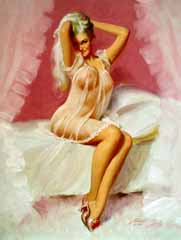 Two artists who are catering to the demand for cheesecake are newcomer
Ted
Kimer and old-timer
Donald "Rusty"
Rust. Both sell classic pin-up art through magazines and on the Web.
Two artists who are catering to the demand for cheesecake are newcomer
Ted
Kimer and old-timer
Donald "Rusty"
Rust. Both sell classic pin-up art through magazines and on the Web.
Rust's art has the classic pin-up look because he's been painting pin-ups and portraits for more than thirty years. Rust lists his influences as Gil Elvgren, Bob Toombs, and Norman Rockwell and his grandfather, Emil Rust. His series of portraits of the clown Emmett Kelly are classic. One of his pin-ups can be seen to the left. She's perhaps a little more revealingly dressed than many of his pin-ups, but she is still a good example of his art.
On his Web site, Rust features both nude and clothed pin-ups. Both series are, by my definitions, cheesecake. The subject matter in both cases is a sexually attractive woman and not either body parts or sexual activity. Neither could be described "sexually explicit".
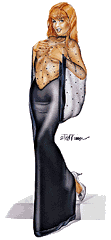 While Kimer is much younger than Rust and his art cruder, his series of
"Teddy Girls" are very much modeled after the pin-ups of the 50's and
60's when Rust's work was first becoming popular. They tease and frolic,
seduce and dress provocatively, but seldom, if ever, are they actually
naked. His art is still a little rough, at least when compared to the
old masters: Zoe Mozert, and Messrs. Vargas, Petty, Moran, and Elvgren,
but he has more heart than Sorayama, for all the latter's technical expertise
and precision. The picture to the right is "Peek-a-boo!", which features
prominently in the Teddy Girl advertising.
While Kimer is much younger than Rust and his art cruder, his series of
"Teddy Girls" are very much modeled after the pin-ups of the 50's and
60's when Rust's work was first becoming popular. They tease and frolic,
seduce and dress provocatively, but seldom, if ever, are they actually
naked. His art is still a little rough, at least when compared to the
old masters: Zoe Mozert, and Messrs. Vargas, Petty, Moran, and Elvgren,
but he has more heart than Sorayama, for all the latter's technical expertise
and precision. The picture to the right is "Peek-a-boo!", which features
prominently in the Teddy Girl advertising.
 The Betty Page boom seems to have affected not only commercial pin-up
artists, but the comic books as well. Comics have a long tradition of
cheesecake and pin-up art, going back at least as far as the "Good Girl"
comics of the 40's such as Bob Ward's Torchy, Eisner/Iger's Sheena,
and Matt Baker's Flamingo.
The Betty Page boom seems to have affected not only commercial pin-up
artists, but the comic books as well. Comics have a long tradition of
cheesecake and pin-up art, going back at least as far as the "Good Girl"
comics of the 40's such as Bob Ward's Torchy, Eisner/Iger's Sheena,
and Matt Baker's Flamingo.
In the mid- to late-50's, about the time Bettie was called before a Congressional investigation, comics, reacting to pressure groups, moved away from cheesecake covers. While the comic book heroines of the 60's and 70's often dressed in skin-tight outfits like their male compatriots, still there really wasn't much in the way of cheesecake or pin-ups. There were, of course, notable exceptions such as Vampirella, many of whose covers were pure cheesecake. To the left is the most famous image of Vampirella which appeared as a cover, in advertising and as a pin-up poster.
After the success of his Rocketeer series, Dave Stevens was much in demand but seldom seen. His meticulous style and loving care, along with his full-time job as a commercial artist, made him one of the slowest artists around. As a result, publishers considered themselves lucky to get him to do just a cover. Naturally, a lot of those covers were pure cheesecake. Two stand out in my memory: his cover for Airboy featuring The Valkyrie and his DNAgents cover featuring a pin-up of Rainbow. The Rainbow cover was particularly suited to pin-up art as the story had her being the subject of a pictorial in a Playboy-like men's magazine.
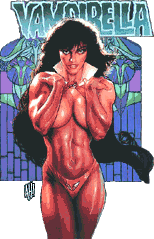 Another artist has since fallen into a very similar pattern as Stevens.
Adam Hughes who is renowned for his beautiful women and his meticulous
style, while perhaps not quite as slow as Dave, still has a hard time
keeping up with the demands of publishing feature stories. As a result
he, too, has become something of a cover artist, again specializing in
beautiful women, and so produces a number of cheesecake shots suitable
for pinning up.
Another artist has since fallen into a very similar pattern as Stevens.
Adam Hughes who is renowned for his beautiful women and his meticulous
style, while perhaps not quite as slow as Dave, still has a hard time
keeping up with the demands of publishing feature stories. As a result
he, too, has become something of a cover artist, again specializing in
beautiful women, and so produces a number of cheesecake shots suitable
for pinning up.
Both Hughes and Stevens have worked not only on costumed superhero comics but on other genres, genres that hark back to the pulps of earlier years. Stevens's Rocketeer was an homage to the Rocketman and similar movie serials. Hughes illustrated Mike Barr's homage to Ellery Queen -- the "play fair" detective series, the Maze Agency.
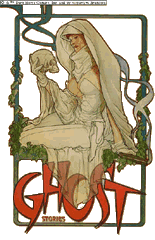 Hughes's style like so many of the cheesecake artists listed here is
slick and clean. And like them, but in contrast with the current vogue
in so much of the comics industry where style is valued to the exclusion
of substance or realism, Hughes' style is highly realistic. To the right
is his version of Vampirella. To the left is his cover for the Ghost graphic novel. The Vampirella is
one of his most super-realistic images. She is shown as a strong
athletic woman whose well-developed muscles are sharply defined.
The shading used to show that definition is exaggerated making the
curves even rounder than they would be in actuality. The Ghost is one of
his more romantic pieces.
Hughes's style like so many of the cheesecake artists listed here is
slick and clean. And like them, but in contrast with the current vogue
in so much of the comics industry where style is valued to the exclusion
of substance or realism, Hughes' style is highly realistic. To the right
is his version of Vampirella. To the left is his cover for the Ghost graphic novel. The Vampirella is
one of his most super-realistic images. She is shown as a strong
athletic woman whose well-developed muscles are sharply defined.
The shading used to show that definition is exaggerated making the
curves even rounder than they would be in actuality. The Ghost is one of
his more romantic pieces.
The balance between the exaggeration of super-realism and the mystery of romanticism seen here in Hughes' work seems to be an ongoing tension in Cheesecake. With it there is a realism that has been eschewed by much of the art of the twentieth century. Both trends are one form or another of idealization, and that is entirely appropriate since Cheesecake is a form of illustration, illustrating the contemporary ideal of feminine beauty, provocativeness, and sexual attractiveness.
Here, for the moment at least, our story ends. The last
of these pages is devoted to FAQ's and other sources for cheesecake on the Web.
Brons
All Rights Reserved.The pictures used to illustrate the styles and artists reviewed here are all copyrighted by their respective creators (or their estates) or publishers and are used without explicit permission. I've done what I can to keep that use within the definitions of fair use.
